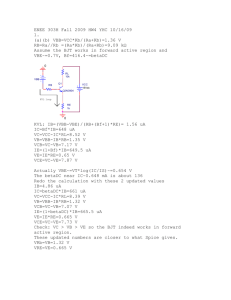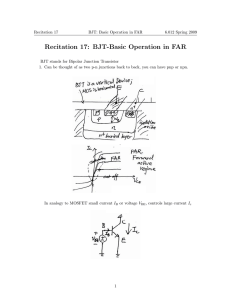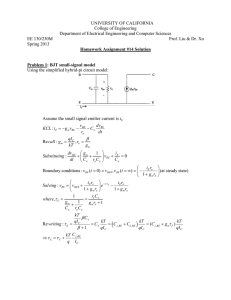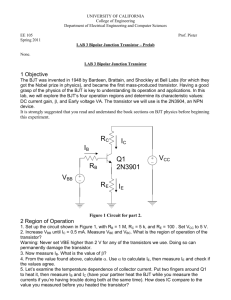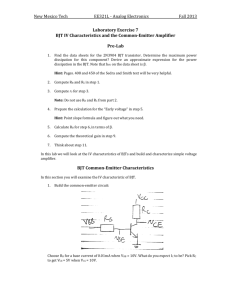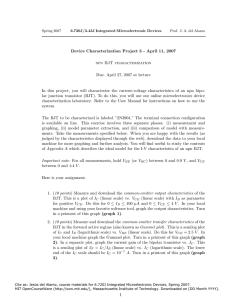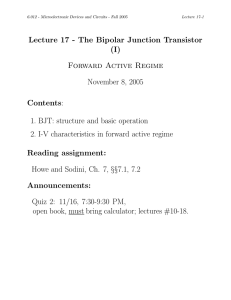Recitation 18: BJT-Regions of Operation & Small Signal Model
advertisement
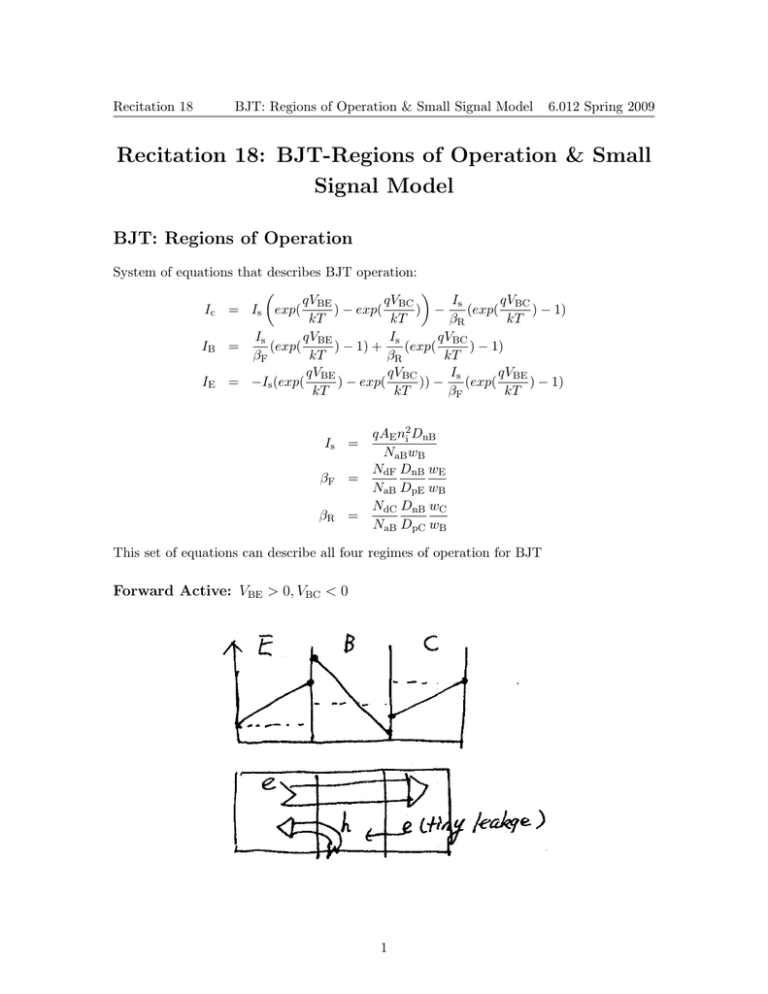
Recitation 18 BJT: Regions of Operation & Small Signal Model 6.012 Spring 2009 Recitation 18: BJT-Regions of Operation & Small Signal Model BJT: Regions of Operation System of equations that describes BJT operation: qVBE qVBC Is qVBC ) − exp( ) − (exp( ) − 1) Ic = Is exp( kT kT βR kT Is qVBE Is qVBC IB = (exp( ) − 1) + (exp( ) − 1) kT kT βF βR qVBE qVBC Is qVBE IE = −Is (exp( ) − exp( )) − (exp( ) − 1) kT kT kT βF Is = βF = βR = qAE n2i DnB NaB wB NdF DnB wE NaB DpE wB NdC DnB wC NaB DpC wB This set of equations can describe all four regimes of operation for BJT Forward Active: VBE > 0, VBC < 0 1 Recitation 18 BJT: Regions of Operation & Small Signal Model Reverse Active (RAR) VBE < 0, VBC > 0 Cut-off VBE < 0, VBC < 0 Saturation VBE > 0, VBC > 0 2 6.012 Spring 2009 Recitation 18 BJT: Regions of Operation & Small Signal Model 6.012 Spring 2009 Understanding the IC vs. VCE curve: IC drops rapidly below VCE,SAT 0.1 to 0.2 V. Why? • Each curve IB is fixed • VCE = VBE − VBC , =⇒ VBC = VBE − VCE • When VCE is large, VBC < 0, FAR. As we reduce VCE , VBC reduces, at some point, VBC starts to become forward biased. Now, hole flux from B → C increases exponentially from Law of Junction; to keep IB constant, hole flux into emitter must be reduced, =⇒ VBE drops, =⇒ IC drops quickly. Small Signal Model of BJT (Next week we will be using BJT & MOSFET for amplifier circuits) Want to know the small signal circuit model of BJT δic 1. Transconductance gm = δVBE Q Ic = Is eqVBE /kT =⇒ gm = Note, different from MOSFET: gm q Ic Is eqVBE /kT = kT Vth w 2 ID (depends upon device size), but not for L bipolar case. 3 Recitation 18 BJT: Regions of Operation & Small Signal Model 6.012 Spring 2009 2. Input resistance: IB = gπ = or γπ = Is qVBE /kT e βF 1 δiB IB gm = = = γπ δVBE Vth βF βF gm The input resistance of MOSFET is ∞. In order to have a high input resistance for BJT, need high current gain βF Example: npn with βF = 150, Ic = mA gm = gπ = Ic 1 × 10−3 A = 40 mS = Vth 0.025 V 40 mS gm = = 0.267 mS (γπ = 3.7 kΩ) βF 150 3. Output resistance: Ebers-Moll model have perfect current source in FAR. Real characteristics show some increase in ic with VCE δic where does go come from? δVCE qAE n2i DnB qVBE /kT = Is eqVBE /kT = e NaB wB go = In FAR: Ic wB shrinks as |VBC | ↑, thus Ic ↑. Model: go = slope = go = 1 Ic = γo VA Ic Ic (VA VCE ) VCE + VA VA Example: Ic = 100 μA, VA = 35 V, =⇒ γo = 350 kΩ VA increases with increasing base width and increasing base doping. This is also why NaB usually NdC 4 Recitation 18 BJT: Regions of Operation & Small Signal Model 6.012 Spring 2009 Now what do we have so far? Need to add capacitances... Junction Capacitance (depletion capacitance) qs NaB NdE (∵ NdE NaB ) 2(NaB + NdE )(φBE − VBE ) qs NdC qs NaB NdC = 2(NaB + NdC )(φBC − VBC ) 2 (φBC − VBE ) (B-E): CjE = (B-E): CjC • Both are functions of bias • Since NaB NdC , CjE CjC . CjC is often called Cμ . Diffusion Capacitance Cb = |QnB | = = Cb = 2 wB 2Dn δ |QnB | δVBE 1 qAE wB npBO eqVBE /kT 2 2 wB wB qAE DnB 1 qVBE /kT wB npBO e = Ic 2 DnB wB 2DnB 2 2 wB wB δ ic = gm δVBE 2DnB 2Dn = τF base diffusion transit time 5 Recitation 18 BJT: Regions of Operation & Small Signal Model Cb is in between base and emitter: Cb + CjE = Cπ Add the following • depletion capacitance: collector to bulk CCS • parasitic resistances: γb of base, γex of emitter, γc of collector Complete small signal model 6 6.012 Spring 2009 MIT OpenCourseWare http://ocw.mit.edu 6.012 Microelectronic Devices and Circuits Spring 2009 For information about citing these materials or our Terms of Use, visit: http://ocw.mit.edu/terms.
